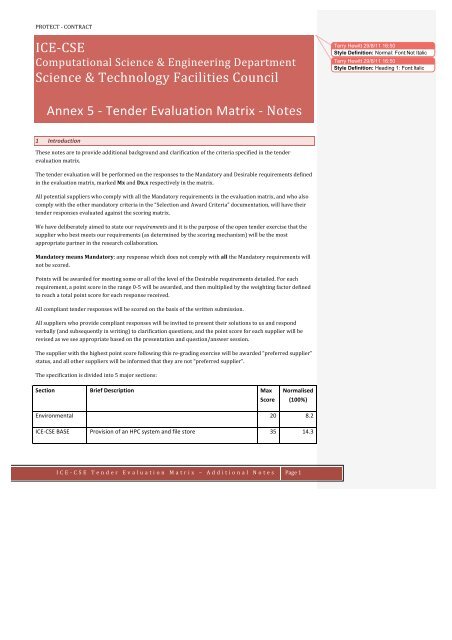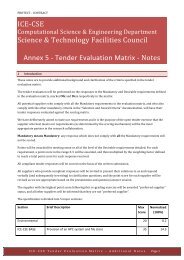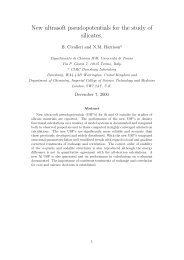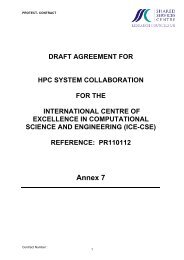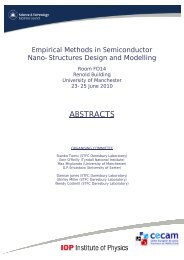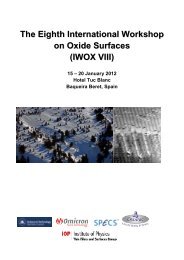Tender Evaluation Matrix Notes v4.0 - STFC's Computational ...
Tender Evaluation Matrix Notes v4.0 - STFC's Computational ...
Tender Evaluation Matrix Notes v4.0 - STFC's Computational ...
You also want an ePaper? Increase the reach of your titles
YUMPU automatically turns print PDFs into web optimized ePapers that Google loves.
PROTECT ‐ CONTRACT<br />
ICE‐CSE<br />
<strong>Computational</strong> Science & Engineering Department<br />
Science & Technology Facilities Council<br />
Terry Hewitt 29/8/11 16:50<br />
Style Definition: Normal: Font:Not Italic<br />
Terry Hewitt 29/8/11 16:50<br />
Style Definition: Heading 1: Font:Italic<br />
Annex 5 ‐ <strong>Tender</strong> <strong>Evaluation</strong> <strong>Matrix</strong> ‐ <strong>Notes</strong><br />
1 Introduction<br />
These notes are to provide additional background and clarification of the criteria specified in the tender<br />
evaluation matrix.<br />
The tender evaluation will be performed on the responses to the Mandatory and Desirable requirements defined<br />
in the evaluation matrix, marked Mx and Dx.x respectively in the matrix.<br />
All potential suppliers who comply with all the Mandatory requirements in the evaluation matrix, and who also<br />
comply with the other mandatory criteria in the “Selection and Award Criteria” documentation, will have their<br />
tender responses evaluated against the scoring matrix.<br />
We have deliberately aimed to state our requirements and it is the purpose of the open tender exercise that the<br />
supplier who best meets our requirements (as determined by the scoring mechanism) will be the most<br />
appropriate partner in the research collaboration.<br />
Mandatory means Mandatory: any response which does not comply with all the Mandatory requirements will<br />
not be scored.<br />
Points will be awarded for meeting some or all of the level of the Desirable requirements detailed. For each<br />
requirement, a point score in the range 0‐5 will be awarded, and then multiplied by the weighting factor defined<br />
to reach a total point score for each response received.<br />
All compliant tender responses will be scored on the basis of the written submission.<br />
All suppliers who provide compliant responses will be invited to present their solutions to us and respond<br />
verbally (and subsequently in writing) to clarification questions, and the point score for each supplier will be<br />
revised as we see appropriate based on the presentation and question/answer session.<br />
The supplier with the highest point score following this re‐grading exercise will be awarded “preferred supplier”<br />
status, and all other suppliers will be informed that they are not “preferred supplier”.<br />
The specification is divided into 5 major sections:<br />
Section Brief Description Max<br />
Score<br />
Normalised<br />
(100%)<br />
Environmental 20 8.2<br />
ICE‐CSE BASE Provision of an HPC system and file store 35 14.3<br />
I C E ‐ C S E T e n d e r E v a l u a t i o n M a t r i x – A d d i t i o n a l N o t e s Page 1
PROTECT ‐ CONTRACT<br />
ICE‐CSE ADVANCE<br />
ICE‐CSE FUTURES<br />
Provision of an “experimental” system on the suppliers<br />
roadmap to Exascale and forms the basis of the collaboration<br />
Access to future products and input by STFC into the suppliers<br />
Exascale computing developments<br />
75 30.6<br />
25 10.2<br />
ICE‐CSE APPS Establishing a collaborative partnership with the supplier 90 36.7<br />
Total 245 100.0<br />
2 Environmental (M0, D0.1, M1, M2, D1.1, D1.2, D1.3)<br />
This section refers to the complete environmental specification of the solution, hence applies in total to the ICE‐<br />
CSE BASE system, the ICE‐CSE ADVANCE system and the file storage system which works with both systems.<br />
The £6m total figure is inclusive of all taxes, most especially VAT, and covers the entirety of the tender response.<br />
We are not asking for a breakdown of spending by system or by component.<br />
Our power budget stated is derived from a limit we have on recurrent operating costs. We have translated our<br />
budget figure into an average 300kW, but are asking suppliers to quote within the peak envelope of 400kW, and<br />
are taking the risk on electricity price fluctuations ourselves.<br />
STFC are commissioning water cooling systems in the Daresbury machine room which the supplier will be<br />
required to use to cool both the ICE‐CSE BASE and the ICE‐CSE ADVANCE systems. The figure of 75% (or<br />
greater) of the heat expelled by the equipment to be cooled by water accounts for heat expelled to air and chilled<br />
by CRAC units by both compute and storage equipment.<br />
We are very interested in high‐temperature cooling options, which allow us to reduce running costs by<br />
minimising the requirement to operate water chillers.<br />
We are also interested in reducing infrastructure costs by using a single chilled water loop which passes through<br />
the computer equipment and also expels air externally, and therefore needs to be include anti‐freeze.<br />
Suppliers should satisfy themselves that they have included all the necessary pipes, heat exchanging equipment<br />
etc (see M2) to connect and utilize the STFC water supply.<br />
2.1 Additional requirements<br />
Suppliers should satisfy themselves that the equipment can be delivered to and installed in the computer hall<br />
using the designated access route. (See M2.)<br />
Suppliers must provide a risk assessment and method statement for delivery and installation of equipment in<br />
advance for approval by STFC.<br />
Responses for the ICS‐CSE BASE and ICS‐CSE ADVANCE systems may differ.<br />
2.2 Hardware Support<br />
The Supplier shall specify the proposed hardware support arrangements for the initial 3 years including:<br />
• Nominated providers of support for all aspects of the hardware<br />
• Contact details for the nominated providers<br />
• Hours of support throughout a calendar year<br />
• Responsibility and capability for fault diagnosis<br />
I C E ‐ C S E T e n d e r E v a l u a t i o n M a t r i x – A d d i t i o n a l N o t e s Page 2
PROTECT ‐ CONTRACT<br />
• Response times for hardware diagnosis and replacement<br />
• Responsibility for delivery, fitting and despatch of parts<br />
• Policy on EOL hardware disposal<br />
• Escalation procedure<br />
2.3 System Software Support<br />
The Supplier shall specify the proposed system software support arrangements for the initial 3 years including:<br />
• A definition of the scope of system software<br />
• Nominated providers of support for all aspects of the system software<br />
• Contact details for the above<br />
• Hours of support throughout a calendar year<br />
• Responsibility and capability for fault diagnosis<br />
• Mechanism for application of fixes and upgrades<br />
• Responsibility for installation of software upgrades<br />
• Escalation procedure<br />
• Tools and interfaces to allow monitoring of the hardware status, including peripherals, and system<br />
software<br />
3 ICE‐CSE BASE (M3, M4, D4.1, D4.2, M5, M6, D6.1, M7, D7.1, M8, D8.1, D8.2)<br />
ICE‐CSE BASE is a “conventional” HPC system, on which we want to be able to engage industrial partners and run<br />
our current suit of HPC applications.<br />
3.1 Permanent File Store<br />
Whilst the file store requirements are specified in the ICE‐CSE BASE section it is emphasised that the file store<br />
must also support the ICE‐CSE ADVANCE system, and should be sized and configured to support both ICE‐CSE<br />
BASE and ICE‐CSE ADVANCE systems and will be expected to meet similar performance requirements with each<br />
system as detailed in the IO benchmark requirements.<br />
3.1.1 Performance<br />
The assessment of file store performance is based upon the ratio (rp)<br />
rp<br />
= aggregatebandwidth<br />
totalmemory<br />
Where<br />
• aggregate bandwidth is in bytes/second<br />
• total memory is in bytes<br />
A minimum rp of 1/1000 is mandatory.<br />
The aggregate performance will be measured using IOR, running on all nodes in both systems at the same time.<br />
The benchmark file will be provided separately, but will run a set of tests at block sizes from 1MB to 512MB,<br />
with transfer sizes from 64k to 1024k.<br />
3.1.1.1 Minimal systems example<br />
Suppose ICE‐CSE BASE has 2048 cores each with 1GB memory and 2 X 256GB large memory nodes. Total<br />
memory = 2,560GB<br />
I C E ‐ C S E T e n d e r E v a l u a t i o n M a t r i x – A d d i t i o n a l N o t e s Page 3
PROTECT ‐ CONTRACT<br />
Suppose ICE‐CSE ADVANCE has 16,384 cores each with 1GB. Total Memory = 16,384 GB<br />
Total memory = 16,384 + 2,560= 18,944 GB<br />
Minimum combined aggregate performance should be 18,944/1000 = 19GB/S<br />
Minimum usable storage capacity = 10 x Total Memory = 10x18,944GB = 189,440 GB which is less than the<br />
200TiB mandatory, therefore usable storage = 200TiB.<br />
3.1.1.2 Maximal Systems (or Mandatory Plus all desirables)<br />
ICE‐CSE BASE: 3072*1GB + 4x 512GB = 5,120GB Memory<br />
ICE‐CSE ADVANCE: 32,768 cores x 1GB/core = 32,768GB Memory<br />
Total Memory: 37,888GB<br />
Minimum combined aggregate performance should be 37,888GB /1000 = 38 GB/S<br />
Minimum usable storage capacity = 15x Combined System Memory = 15x37,888 = 568,320GB<br />
3.2 Power Consumption<br />
We are keen to minimise operating costs and believe this can be accomplished if we are able to monitor and<br />
control power usage down to the level of single parallel jobs. Tools which enable us to perform this task are<br />
therefore desired.<br />
4 ICE‐CSE ADVANCE System (M9, D9.1, D9.2, D9.3, D9.4, M10, M10.1, M11, D11.1, D11.2, D11.3, M12)<br />
The ICE‐CSE ADVANCE system should represent “state of the art” technology in the supplier’s roadmap along the<br />
path to Exascale computing. We wish to use this system to<br />
• demonstrate extreme parallel scaling and performance over a large number of nodes,<br />
• to optimise existing codes in order to enable them to run on future Exascale systems and<br />
• to develop new codes where existing codes have reached the limit of their capabilities.<br />
5 ICE‐CSE FUTURE (M13, D13.1, D13.2, D13.3)<br />
The reason for establishing the ICE‐CSE collaboration is to give us access to new technology developments when<br />
they become available. We recognise that we cannot pre‐pay for future hardware, and therefore do not require<br />
that new hardware be delivered to us on site in Daresbury, but we want to define part of the collaboration as<br />
giving us access to this sort of equipment.<br />
We also want to be able to contribute to our partner’s product development plans, so having access to preproduction<br />
equipment and a feedback route back into product development will both help enable this.<br />
6 ICE‐CSE APPS (M14, D14.1, D14.2, D14,3, D14.4, D14.5, D14.6, D14.7, D14.8)<br />
We ask that the supplier prepare a business plan, governance structure and examples of similar collaborations in<br />
which various aspects of the collaboration might be included.<br />
We intend that this collection of requirements is consistent with information CSED has published: that the<br />
“collaboration” aspect of ICE‐CSE is vitally important to us and that we intend to recognise input in this area<br />
significantly in determining our preferred supplier.<br />
I C E ‐ C S E T e n d e r E v a l u a t i o n M a t r i x – A d d i t i o n a l N o t e s Page 4
PROTECT ‐ CONTRACT<br />
The ICE‐CSE collaboration should be viewed as a stepping stone to a longer term and larger venture, which we<br />
have been discussing for a number of years. We continue to seek additional funding and urge collaborators to<br />
think of how the role of the ICE‐CSE collaboration could be expanded with additional funding.<br />
6.1 D14.8<br />
Additional capital and recurrent funds are most likely to come from the Department for Business, Innovation &<br />
Skills (BIS). Typically this must be matched by investments from other partners.<br />
Suppliers might like to consider initiatives such as Technology Innovation Centres (TICs) and their funding<br />
models.<br />
I C E ‐ C S E T e n d e r E v a l u a t i o n M a t r i x – A d d i t i o n a l N o t e s Page 5


